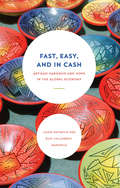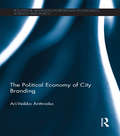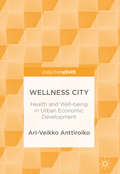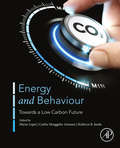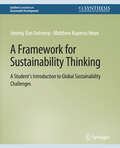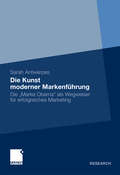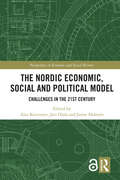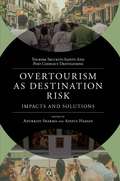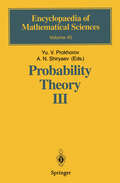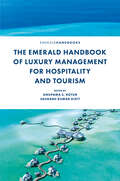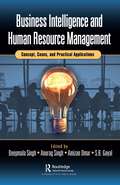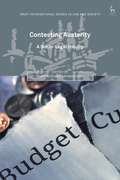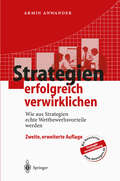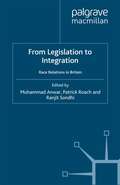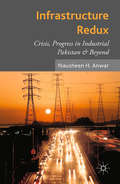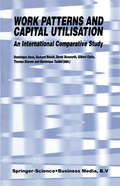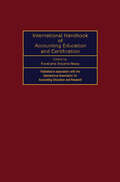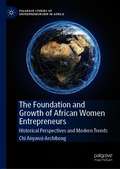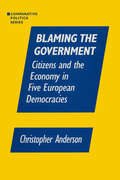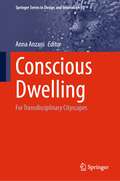- Table View
- List View
Fast, Easy, and In Cash: Artisan Hardship and Hope in the Global Economy
by Jason Antrosio Rudi Colloredo-Mansfeld“Artisan” has become a buzzword in the developed world, used for items like cheese, wine, and baskets, as corporations succeed at branding their cheap, mass-produced products with the popular appeal of small-batch, handmade goods. The unforgiving realities of the artisan economy, however, never left the global south, and anthropologists have worried over the fate of resilient craftspeople as global capitalism remade their cultural and economic lives. Yet artisans are proving to be surprisingly vital players in contemporary capitalism, as they interlock innovation and tradition to create effective new forms of entrepreneurship. Based on seven years of extensive research in Colombia and Ecuador, veteran ethnographers Jason Antrosio and Rudi Colloredo-Mansfeld’s Fast, Easy, and In Cash explores how small-scale production and global capitalism are not directly opposed, but rather are essential partners in economic development. Antrosio and Colloredo-Mansfeld demonstrate how artisan trades evolve in modern Latin American communities. In uncertain economies, small manufacturers have adapted to excel at home-based production, design, technological efficiency, and investments. Vivid case studies illuminate this process: peasant farmers in Túquerres, Otavalo weavers, Tigua painters, and the t-shirt industry of Atuntaqui. Fast, Easy, and In Cash exposes how these ambitious artisans, far from being holdovers from the past, are crucial for capitalist innovation in their communities and provide indispensable lessons in how we should understand and cultivate local economies in this era of globalization.
Fast, Easy, and In Cash: Artisan Hardship and Hope in the Global Economy
by Jason Antrosio Rudi Colloredo-Mansfeld“Artisan” has become a buzzword in the developed world, used for items like cheese, wine, and baskets, as corporations succeed at branding their cheap, mass-produced products with the popular appeal of small-batch, handmade goods. The unforgiving realities of the artisan economy, however, never left the global south, and anthropologists have worried over the fate of resilient craftspeople as global capitalism remade their cultural and economic lives. Yet artisans are proving to be surprisingly vital players in contemporary capitalism, as they interlock innovation and tradition to create effective new forms of entrepreneurship. Based on seven years of extensive research in Colombia and Ecuador, veteran ethnographers Jason Antrosio and Rudi Colloredo-Mansfeld’s Fast, Easy, and In Cash explores how small-scale production and global capitalism are not directly opposed, but rather are essential partners in economic development. Antrosio and Colloredo-Mansfeld demonstrate how artisan trades evolve in modern Latin American communities. In uncertain economies, small manufacturers have adapted to excel at home-based production, design, technological efficiency, and investments. Vivid case studies illuminate this process: peasant farmers in Túquerres, Otavalo weavers, Tigua painters, and the t-shirt industry of Atuntaqui. Fast, Easy, and In Cash exposes how these ambitious artisans, far from being holdovers from the past, are crucial for capitalist innovation in their communities and provide indispensable lessons in how we should understand and cultivate local economies in this era of globalization.
New Urban Management: Attracting Value Flows To Branded Hubs
by A. AnttiroikoNew Urban Management discusses how the logic of economic flows poses a challenge to local governments throughout the world. The book argues that the increased fluidity in economic life must have its reflection in local economic development policy.
The Political Economy of City Branding (Routledge Advances in Regional Economics, Science and Policy)
by Ari-Veikko AnttiroikoGlobalization affects urban communities in many ways. One of its manifestations is increased intercity competition, which compels cities to increase their attractiveness in terms of capital, entrepreneurship, information, expertise and consumption. This competition takes place in an asymmetric field, with cities trying to find the best possible ways of using their natural and created assets, the latter including a naturally evolving reputation or consciously developed competitive identity or brand. The Political Economy of City Branding discusses this phenomenon from the perspective of numerous post-industrial cities in North America, Europe, East Asia and Australasia. Special attention is given to local economic development policy and industrial profiling, and global city rankings are used to provide empirical evidence for cities’ characteristics and positions in the global urban hierarchy. On top of this, social and urban challenges such as creative class struggle are also discussed. The core message of the book is that cities should apply the tools of city branding in their industrial promotion and specialization, but at the same time take into account the special nature of their urban communities and be open and inclusive in their brand policies in order to ensure optimal results. This book will be of interest to scholars and practitioners working in the areas of local economic development, urban planning, public management, and branding.
The Political Economy of City Branding (Routledge Advances in Regional Economics, Science and Policy #2)
by Ari-Veikko AnttiroikoGlobalization affects urban communities in many ways. One of its manifestations is increased intercity competition, which compels cities to increase their attractiveness in terms of capital, entrepreneurship, information, expertise and consumption. This competition takes place in an asymmetric field, with cities trying to find the best possible ways of using their natural and created assets, the latter including a naturally evolving reputation or consciously developed competitive identity or brand. The Political Economy of City Branding discusses this phenomenon from the perspective of numerous post-industrial cities in North America, Europe, East Asia and Australasia. Special attention is given to local economic development policy and industrial profiling, and global city rankings are used to provide empirical evidence for cities’ characteristics and positions in the global urban hierarchy. On top of this, social and urban challenges such as creative class struggle are also discussed. The core message of the book is that cities should apply the tools of city branding in their industrial promotion and specialization, but at the same time take into account the special nature of their urban communities and be open and inclusive in their brand policies in order to ensure optimal results. This book will be of interest to scholars and practitioners working in the areas of local economic development, urban planning, public management, and branding.
Wellness City: Health and Well-being in Urban Economic Development
by Ari-Veikko AnttiroikoAddressing the continuous need for new growth sectors in post-industrial cities, this book considers the economic significance of wellness from a development policy perspective. The author goes beyond personal health discourse to conceptualise wellness as an emerging industry, presenting empirical cases of community, attraction, and export-orientated strategies around the world. Combining holistic health, urban governance and economic development, this book will provide valuable reading for those studying policy, tourism and the wellness sector as well as business entrepreneurs within this evolving industry.
Wellness City: Health and Well-being in Urban Economic Development
by Ari-Veikko AnttiroikoAddressing the continuous need for new growth sectors in post-industrial cities, this book considers the economic significance of wellness from a development policy perspective. The author goes beyond personal health discourse to conceptualise wellness as an emerging industry, presenting empirical cases of community, attraction, and export-orientated strategies around the world. Combining holistic health, urban governance and economic development, this book will provide valuable reading for those studying policy, tourism and the wellness sector as well as business entrepreneurs within this evolving industry.
Energy and Behaviour: Towards a Low Carbon Future
by Carlos Henggeler Antunes Marta Lopes Kathryn B. JandaChanges to energy behaviour — the role of people and organisations in energy production, use and efficiency — are critical to supporting a societal transition towards a low carbon and more sustainable future. However, which changes need to be made, by whom, and with what technologies are still very much under discussion. This book, developed by a diverse range of experts, presents an international and multi-faceted approach to the sociotechnical challenge of engaging people in energy systems and vice versa. By providing a multidisciplinary view of this field, it encourages critical thinking about core theories, quantitative and qualitative methodologies, and policy challenges. It concludes by addressing new areas where additional evidence is required for interventions and policy-making. It is designed to appeal to new entrants in the energy-efficiency and behaviour field, particularly those taking a quantitative approach to the topic. Concurrently, it recognizes ecological economist Herman Daly’s insight: what really counts is often not countable. Introduces the major disciplinary and interdisciplinary approaches to understanding energy and behaviourDelivers a cross-sectoral overview including energy behaviour in buildings, industry, transportation, smart grids, and smart citiesReviews a selection of innovative energy behaviour modelling approaches, including agent-based modelling, optimization, and decision supportCritically addresses the importance of interventions, policies, and regulatory design
A Framework for Sustainability Thinking: A Student’s Introduction to Global Sustainability Challenges (Synthesis Lectures on Sustainable Development)
by Jeremy Van Antwerp Matthew Kuperus HeunThis book is an introduction to the many challenges of sustainability. The first half of the book develops a framework for sustainability thinking. The second half considers application areas and personal and corporate responses to sustainability challenges. Basic facts, figures, and information related to sustainability are presented in a way that should convey to readers a sense of scale for the many sustainability challenges we face. Throughout, the end-of-chapter projects and discussion questions focus on tradeoffs among competing goods and the ethical and social implications of decisions related to sustainability. This book was written for a university seminar course on sustainability but could be used in other small-group discussion settings. It is intended to be easy to read but hard to digest.
Die Kunst moderner Markenführung: Die „Marke Obama“ als Wegweiser für erfolgreiches Marketing
by Sarah AntwerpesSarah Antwerpes analysiert die Erfolgsfaktoren der Markenführung und leitet die Anwendbarkeit des „Obama-Phänomens“ für Unternehmen ab: Sie zeigt, wie es Obamas Team in wenigen Monaten gegen eine etablierte Konkurrenz gelungen ist, eine der wertvollsten Marken der Welt zu kreieren.
The Nordic Economic, Social and Political Model: Challenges in the 21st Century (Perspectives in Economic and Social History)
by Anu Koivunen; Jari Ojala; Janne HolménThe Nordic Model is the 20th-century Scandinavian recipe for combining stable democracies, individual freedom, economic growth and comprehensive systems for social security. But what happens when Sweden and Finland – two countries topping global indexes for competitiveness, productivity, growth, quality of life, prosperity, and equality – start doubting themselves and their future? Is the Nordic Model at a crossroads? Historically, consensus, continuity, social cohesion, and broad social trust have been hailed as key components for the success and for the self-images of Sweden and Finland. In the contemporary, however, political debates in both countries are increasingly focused on risks, threats, and worry. Social disintegration, political polarization, geopolitical anxieties, and threat of terrorism are often dominant themes. This book focuses on what appears to be a paradox: countries with low income differences, high faith in social institutions, and relatively high cultural homogeneity becoming fixated on the fear of polarization, disintegration, and diminished social trust. Unpacking the presentist discourse of "worry" and a sense of interregnum at the face of geopolitical tensions, digitalization, and globalization, as well as challenges to democracy, the chapters take steps back in time and explore the current conjecture through the eyes of historians and social scientists, addressing key aspects of and challenges to both the contemporary and future Nordic Model. In addition, the functioning and efficacy of the participatory democracy and current protocols of decision-making are debated. This work is essential reading for students and scholars of the welfare state, social reforms, and populism, as well as Nordic and Scandinavian studies.
Overtourism as Destination Risk: Impacts and Solutions (Tourism Security-Safety and Post Conflict Destinations)
by Anukrati Sharma, Azizul HassanThe tourism industry provides a vital lifeline in helping to develop and enhance the economic growth of cities, states, and nations, but there is growing concern internationally about how overtourism in certain regions is having an adverse impact on a number of tourist destinations. Overtourism as Destination Risk: Impacts and Solutions presents a range of researcher perspectives discussing current issues in the overtourism debate, including unplanned expansion and construction, environmental imbalance and damage, pollution and deforestation, as well as measures and possible solutions to tackle the problem of overtourism and its spread. This book specifically focuses on Coimbra in Portugal, Amsterdam in the Netherlands and Shimla in India. This book foregrounds the tourist's responsibility to respect destinations and provides an in-depth assessment of possible risk factors and the conflicted role of the media and marketing organizations as image-makers of tourist destinations. This book is essential reading for academics and researchers from the fields of tourism studies, social sciences, environmental sciences, humanities and relevant disciplines.
Probability Theory III: Stochastic Calculus (Encyclopaedia of Mathematical Sciences #45)
by S. V. Anulova N. V. Krylov R. S. Liptser A. N. Shiryaev A. Yu. VeretennikovThis volume of the Encyclopaedia is a survey of stochastic calculus, an increasingly important part of probability, authored by well-known experts in the field. The book addresses graduate students and researchers in probability theory and mathematical statistics, as well as physicists and engineers who need to apply stochastic methods.
The Emerald Handbook of Luxury Management for Hospitality and Tourism
by Anupama S. Kotur, Saurabh Kumar DixitLuxury is an ever-evolving concept with various interpretations in the domain of hospitality and tourism. The understanding of luxury hospitality and travel has revolved around exclusive and authentic experiences, nuanced by finer things with a focus on value rather than price. The marketing of luxury products and services has become increasingly complex as these products and services are associated not only with an image of quality, performance, and authenticity but also with how extreme experiences and products fulfil the lifestyle constructs of consumers. The Emerald Handbook of Luxury Management for Hospitality and Tourism brings together global philosophies, principles and practices in luxury tourism management from both supply and demand perspectives. Several global case studies are presented, further illustrating the changing paradigms of luxury travel market and consumers enabling insight into the upcoming global luxury travel market. Encompassing the vibrant case studies and contemporary discussions on luxury hospitality and tourism developments during the post-pandemic era, this volume will serve as an essential resource for students, researchers, and industry practitioners of hospitality, tourism, management, and marketing consumer behavior, and consumer studies.
Business Intelligence and Human Resource Management: Concept, Cases, and Practical Applications
by Singh Anurag Omar Amizan Goyal S. B. Singh DeepmalaBusiness Intelligence (BI) is a solution to modern business problems. This book discusses the relationship between BI and Human Resource Management (HRM). In addition, it discusses how BI can be used as a strategic decision-making tool for the sustainable growth of an organization or business. BI helps organizations generate interactive reports with clear and reliable data for making numerous business decisions. This book covers topics spanning the important areas of BI in the context of HRM. It gives an overview of the aspects, tools, and techniques of BI and how it can assist HRM in creating a successful future for organizations. Some of the tools and techniques discussed in the book are analysis, data preparation, BI-testing, implementation, and optimization on GR and management disciplines. It will include a chapter on text mining as well as a section of case studies for practical use. This book will be useful for business professionals, including but not limited to, HR professionals, and budding business students.
Contesting Austerity: A Socio-Legal Inquiry (Oñati International Series in Law and Society)
by Anuscheh Farahat and Xabier ArzozThis book addresses the different forms of austerity, contestation and resistance, in order to understand how they relate to one another and the impact they have on the democratic quality of public debates, the trust in public institutions and the legitimacy of law. Contestation of austerity includes not only traditional activism strategies such as human rights litigation and direct democracy instruments, but also new forms of collective action and collaborative resistance. Most importantly, many of the new anti-austerity initiatives also aim to renovate existing modes of democratic decision-making on the European, national, regional and local levels. The book focuses on different types of contesting austerity measures and the interaction between institutional and civil society actors. It will enhance understanding of how the various actors frame not only their goal but also the underlying social conflict to contest austerity and through which means they try to achieve political and legal changes. With 16 chapters written by contributors from Spain, Germany, Greece, Portugal and the UK, the book approaches 3 crucial areas of austerity policies: cuts in payment and pensions, labour law reform, and old and new poverty. In each field, the contributors analyse the processes of decision-making and contestation from 3 perspectives: institutions, democratic theory and societal responses.
Strategien erfolgreich verwirklichen: Wie aus Strategien echte Wettbewerbsvorteile werden
by Armin AnwanderEine Vision zu haben ist die eine Sache, sie zum Alltagshandeln aller Akteure zu machen eine ganz andere. Das Buch zeigt Schritt für Schritt, wie eine Führungsmannschaft ihre Strategien schneller, konsequenter, flächendeckender und nachhaltiger als der Wettbewerb verwirklichen kann. Die Navigationsinstrumente der Strategieverwirklichung bieten dabei ein anschauliches und praxiserprobtes Handwerkszeug, mit dem es auf dem Weg aus einer Alten in eine Neue Welt jederzeit gelingt, den eigenen Standort zu bestimmen, das Umfeld einzuschätzen und zu entscheiden, in welche Richtung und wie man am besten voranschreitet.
From Legislation to Integration?: Race Relations in Britain (Migration, Diasporas and Citizenship)
by M. Anwar P. Roach R. SondhiBritain is now permanently a multi-racial and multi-cultural society, with a race relations legislative framework. From Legislation to Integration? provides a unique and comprehensive analysis of the contribution made by this legislation to the development of British race relations. The politics of the Race Relations Act 1976, the issues regarding law enforcement and the impact of legislation in British race relations are examined. Contextualising Britain, the book puts the situation in this country within the European Union framework and compares it with the United States. It also looks to the future and makes relevant suggestions to improve the current legislation. It will appeal to students of social sciences, researchers, policy-makers and professionals in the relevant fields, nationally and internationally.
Infrastructure Redux: Crisis, Progress in Industrial Pakistan & Beyond
by N. AnwarThe focus of this book is on industrial infrastructures of production and circulation, from power distribution and roads to dry ports and airports. It looks at how these infrastructures underpin visions of progress and mediate relations between the state and capitalist firms in industrializing districts in Punjab, Pakistan.
Work Patterns and Capital Utilisation: An International Comparative Study
by D. Anxo Gerhard Bosch Derek Bosworth Gilbert Cette Thomas Sterner Dominique TaddeiEdmond Malinvaud This book provides a most welcome survey of what statisticians and economists know about an aspect of production that is difficult to precisely characterize but matters a lot for both its importance on economic performance and its social implications. That such a survey is timely cannot be overemphasized; the point is well argued in the introduction to the book, which shows how discussions of the last decades stressed the importance of capital operating time as an economic variable in a series of distinct but interrelated topics, from growth theory to employment policies. Nowadays still more than ever in the past, production not only requires capital as well as labour but also depends on varied and complex forms of work organization, which tie more or less closely to one another the uses of the two main factors. In industry and services labour needs many pieces of capital for efficient production, some operating permanently others assisting when needed. Many, even among the most modem equipments, cannot well function without constant guidance or control by human labour. The cost of interrupting some industrial processes is so high as to impose continuous operation. The timing for the provision of many services has to be patterned in accordance with the rhythms of activities or requirements of those demanding these services, and so on. This interplay is so complex that its particularities were, and still are most often, fully neglected in statistical information and in economic analysis.
International Handbook of Accounting Education and Certification: Published in Association with the International Association for Accounting Education and Research
by Kwabena Anyane-NtowThis is the first work of its kind. Original contributions from leading academicians, practitioners and accounting associations from around the world make this handbook a unique source of information on international accounting education and certification processes. A uniform format in most of the chapters allows for easy comparison between countries. This volume documents the development of accounting education and practice at country and global levels; studies the sensitivity of accounting education and practices to the unique socio-economic needs of its environment; and allows comparative studies at a time when attempts have begun to harmonize accounting education internationally. Most importantly, it shows how educational programmes around the world are preparing future accounting professionals to deal with the rapid technological and environmental changes of the 21st century.
The Foundation and Growth of African Women Entrepreneurs: Historical Perspectives and Modern Trends (Palgrave Studies of Entrepreneurship in Africa)
by Chi Anyansi-ArchibongThis book explores how culture and tradition have impacted the tendency for African women to opt for entrepreneurship. The first section presents literature on the concept of entrepreneurship and introduces traditional African women entrepreneurs—the first-generation, culture-driven entrepreneurs, driven by the need to alleviate poverty within the family. The second section covers the modern, second-generation entrepreneurs driven by such forces as education, globalization, and technology. Further, the author assesses the regional perspectives on entrepreneurship and explores the entrepreneurial ecosystems to determine their relevance to the development of entrepreneurial spirit in Africa and among women in particular. This book expands on knowledge about the role that women play in the socio-economic development of the African continent.
Blaming the Government: Citizens and the Economy in Five European Democracies
by Christopher A. AnzaloneThis work examines the impact of macroeconomic conditions on public support for the government in Britain, France, Netherlands, Denmark and Germany.
Blaming the Government: Citizens and the Economy in Five European Democracies
by Christopher A. AnzaloneThis work examines the impact of macroeconomic conditions on public support for the government in Britain, France, Netherlands, Denmark and Germany.
Conscious Dwelling: For Transdisciplinary Cityscapes (Springer Series in Design and Innovation #20)
by Anna AnzaniThrough a transdisciplinary perspective, this book examines the complex urban dimension, in front of increasing density, soil consumption, abandoned places, and the recent pandemic which proved megacities particularly inadequate to provide healthy psychophysical conditions. Assuming bodily and emotional comfort as a reference horizon, it tends to inspire the design research overcoming a paradoxical binary logic that separates public and private, outside and inside, culture and nature, mind and places. The first part of the work explores built spaces and addresses sustainable strategies not only to overcome an ecologic and systemic crisis but also to improve places liveability in our contemporary city. The second part deals with our perception of aesthetic spaces, welcoming the stimuli coming from neuro-aesthetics studies on affordances and atmosphere and encouraging the intersection between interior architecture and design culture and arts. The third part examines relational spaces and how they influence human behaviour, starting from psychological, anthropological, and philosophical perspectives. The book benefits scholars and practitioners interested in interior architecture and design, as well as researchers involved in the relationship between people and places. The new challenge posed by the recent pandemic requires more than ever to rely on consciousness, culture and creativity to increase the intelligence of our surroundings, allowing our sense of belonging and improving our personal and mutual well-being.
